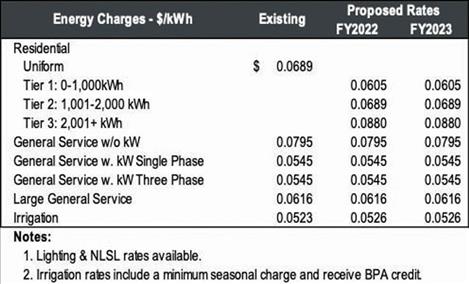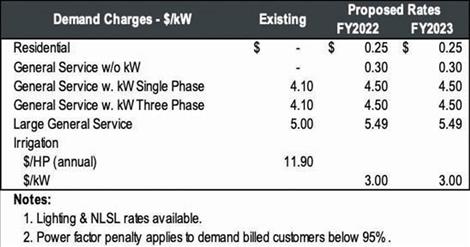Mission Valley Power explains rate changes
Hey savvy news reader! Thanks for choosing local.
You are now reading
1 of 3 free articles.
PABLO — Consumer rates at Mission Valley Power have changed as of April 1. What that means for different groups of consumers has left some confused. Jean Matt of Mission Valley Power explained the changes, and the ways in which they impact everyone.
The power company had a rate study conducted earlier this year by the FCS Group out of Washington to determine the company’s financial needs and propose changes to meet those needs. The first step was to determine the revenue requirement for the company to function, determine cost of service class allocation, and design rates to achieve the target revenue. According to Matt, this has been the company’s first rate change evaluation since 2013.
A cost of service adjustment (COSA) conducted as part of the study measured the usage and demand correlated to different customer classes, including residential, irrigators, and net metering customers who produce some of their own power via solar panels and the like. What was discovered was that some groups were unintentionally subsidizing the electricity of others, the biggest examples being irrigators paying 53.2% under the rate recommended by the COSA, and net metering customers paying 59.6% under.
“The rate for irrigators hasn’t changed in 34 years,” Matt stated. As for net metering, solar power is only available when the sun is shining, so net metering customers still rely on the power company during the evening and in cloudy weather. This meant the group of approximately 55 customers had rates, according to the report, that were also subsidized by the residential group. Matt explained this happened because they were being charged the same rate as residential even as Mission Valley Power bought back what they produce, resulting in a disproportionate financial break for net metering.
Additionally, the COVID pandemic put a strain on residential electricity customers as people began spending significantly more time at home and used more residential power. This paired with the existing rate structure placed too much of the financial burden on the residential category, according to Matt. This resulted in the biggest break in cost for residential customers, the company’s largest client group with approximately 20,000 customers, when rates were restructured.
“It’s a rate adjustment, not a rate increase,” Matt explained. “Some groups will pay less, others will pay more.” One of the biggest differences was the change of fixed charges versus variable charges.
The basic monthly charge for residents, not accounting for demand, has increased by $2.50, from $15 on a non-prepaid meter to $17.50.
One change residents will see is that the company has introduced a demand charge of $0.25 per kilowatt. Like other electric companies, demand will be determined by the highest peak a customer uses within 15 minutes in a 30-day period. This variable charge for residential customers is based on one of three tiers of kilowatt hours (kWh), where one kWh is equal to the amount of energy used if a single 1,000-watt appliance was kept running for one hour. Tier one is 0-1,000 kWh with a charge of about six cents, tier two is 1,001-2,000 kWh with a charge of about seven cents, and tier three is 2,001 kWh and over with a charge of about nine cents. According to Matt, the variable rates are intended to incentivize energy conservation on the part of the customer.
General service customers without demand also saw a basic monthly charge increase of $2.50 from $15.00 to $17.50, as well as a demand charge of $0.30 per kilowatt. General service with demand, however, saw increases in both single phase and three phase.
Single phase sees an annual average of 4,000 kWh and can cost the power company more to build out to due to the use of specialized equipment. In response, their basic monthly charge has been increased by $5.00 from $27.50 to $32.50 with a demand charge increase of $0.40 from $4.10 to $4.50 per kilowatt. Phase three, with an annual average of 17,500 kWh, has had their basic monthly charge increased by $8.25 from $45.00 to $53.25, with a demand charge increase of $0.40 from $4.10 to $4.50 per kilowatt.
As for irrigators, they now have a basic monthly charge they did not have previously. The COSA report recommended the basic charge for irrigators be set at $55.86, but the monthly rate settled on by Mission Valley was $5. Additionally, the irrigator’s demand charge will be changed from $11.90 based on the horsepower of their pumps and charged annually to $3.00 per kilowatt. Their energy charge was not significantly changed, increasing from $0.0523 per kWh to $0.0526.
Net metering customers have seen basic charges adjusted to account for the increased costs of metering and customer service. A single phase $5.00, and three phase $8.25 monthly basic fee was implemented for this group, though Matt stressed that the power company buys whatever they overproduce at wholesale value. This rate will also be revisited as more net metering customers are connected to the system and advanced AMI meters are deployed.
The demand charge, for some customer groups, is new. “Who we buy power from charges us for demand for all rate classes. For the past 11 years, we’ve paid demand for the customers. We can’t afford to do that anymore,” Matt stated.
Fees have been reduced this year, such as the late fee for prepay exempted reduced from a charge of $15, $40, or $60, down to 1.5% of the bill.
While some groups will see an increase in their rates due to the financial restructuring, the COSA report recommended much higher rate increases across the board, sometimes ten times greater than what Mission Valley implemented.
“We can’t go to COSA right away, that would be punitive,” Matt said. Instead, he said he hopes to incentivize the conservation of electricity among customers and reduce the costs of operation for the business itself to help minimize rate increases in the future.
The company, a nonprofit that does not receive funding from either the federal or managing Tribal governments, is rate payer funded. One common misconception is they generate electricity via the dam, however the company does not own the dam and does not generate its own power. Their assets are owned by the federal government, and unlike a for profit structure or cooperative, they are not allowed to borrow money.
Operated by unionized employees, according to Matt Mission Valley Power has consolidated a number of positions in their organization to reduce costs and invested in improvements to decrease the number of manhours spent in maintenance and emergencies. One such improvement has been the purchase of an advanced metering system to both gain a better read on the demand for all customers and address issues such as outages faster. Around 750,000 units will arrive this week and begin to be installed in Arlee, working their way north.
Another key component of the rate increases Matt asks consumers to keep in mind is that Mission Valley Power’s cost of operation has increased as well. Their capital needs include costs for physical backups for power such as extra conductors and maintaining the operating reserve of power of $4.5 million for emergencies, a reserve he says needs to be increased. While their capital spending is about 25% of their budget, inflation caused by supply chain issues has impacted them as well. Transformers, Matt gave as an example, cost 50 to 60% higher this year than last.
As the rate study concludes that the present rates are not sufficient to cover the company’s current obligations, the rate structure will be revisited by 2024.
A comprehensive breakdown of the updated rate schedule and classes can be viewed at missionvalleypower.org/wp-content/uploads/2022/03/Rate-Schedule-effective-APR-2022-Final.pdf. Annual reports and the operation manual detailing the customer appeals process can be found on the Mission Valley Power website under the resources tab. The updated service fees can be viewed under the service forms tab. Any additional questions can be answered by calling 406-883-7900.

















